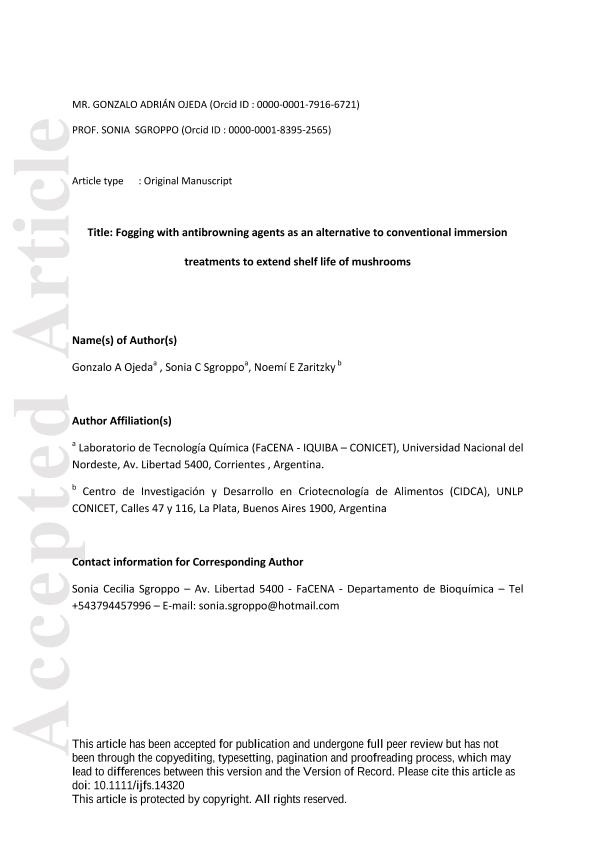Mostrar el registro sencillo del ítem
dc.contributor.author
Ojeda, Gonzalo Adrian

dc.contributor.author
Sgroppo, Sonia Cecilia

dc.contributor.author
Zaritzky, Noemi Elisabet

dc.date.available
2020-11-18T18:46:22Z
dc.date.issued
2020-02
dc.identifier.citation
Ojeda, Gonzalo Adrian; Sgroppo, Sonia Cecilia; Zaritzky, Noemi Elisabet; Fogging with antibrowning agents as an alternative to conventional immersion treatments to extend shelf life of mushrooms; Wiley Blackwell Publishing, Inc; International Journal of Food Science and Technology; 55; 3; 2-2020; 660-668
dc.identifier.issn
0950-5423
dc.identifier.uri
http://hdl.handle.net/11336/118623
dc.description.abstract
Mushroom (Agaricus bisporus) is a highly perishable product and can be easily damaged when immersion in antibrowning solutions is performed; therefore, fogging application represents a less aggressive technique.The objective of this work was to evaluate the effect of different antibrowning agents (ascorbicacid, sodium metabisulphite and L-cysteine) applied by two methodologies (immersion and fogging) on the quality of mushrooms during storage at 5 °C. Weight losses, microstructural organisation, colour and texture changes were evaluated as quality indicators. Polyphenol oxidase activity, phenolic content and antioxidant activity were also evaluated. Fogging achieved browning inhibition without major changes in firmness, while immersion treatments inhibited browning but significant changes in firmness were found.Browning inhibition achieved by fogging showed similar results when compared to the conventional immersion treatments. Fogging has the advantage of being less aggressive than immersion while requiring a significantly smaller amount of antibrowning solution than traditional immersion.
dc.format
application/pdf
dc.language.iso
eng
dc.publisher
Wiley Blackwell Publishing, Inc

dc.rights
info:eu-repo/semantics/openAccess
dc.rights.uri
https://creativecommons.org/licenses/by-nc-sa/2.5/ar/
dc.subject
ANTIOXIDANTS
dc.subject
ENZYMATIC BROWNING
dc.subject
FOGGING
dc.subject
MICROSTRUCTURE
dc.subject
MUSHROOMS
dc.subject
POLYPHENOL OXIDASE
dc.subject.classification
Alimentos y Bebidas

dc.subject.classification
Otras Ingenierías y Tecnologías

dc.subject.classification
INGENIERÍAS Y TECNOLOGÍAS

dc.title
Fogging with antibrowning agents as an alternative to conventional immersion treatments to extend shelf life of mushrooms
dc.type
info:eu-repo/semantics/article
dc.type
info:ar-repo/semantics/artículo
dc.type
info:eu-repo/semantics/publishedVersion
dc.date.updated
2020-11-18T16:14:35Z
dc.identifier.eissn
1365-2621
dc.journal.volume
55
dc.journal.number
3
dc.journal.pagination
660-668
dc.journal.pais
Reino Unido

dc.journal.ciudad
Londres
dc.description.fil
Fil: Ojeda, Gonzalo Adrian. Consejo Nacional de Investigaciones Científicas y Técnicas; Argentina. Universidad Nacional del Nordeste. Facultad de Ciencias Exactas y Naturales y Agrimensura; Argentina
dc.description.fil
Fil: Sgroppo, Sonia Cecilia. Consejo Nacional de Investigaciones Científicas y Técnicas; Argentina. Universidad Nacional del Nordeste. Facultad de Ciencias Exactas y Naturales y Agrimensura; Argentina
dc.description.fil
Fil: Zaritzky, Noemi Elisabet. Provincia de Buenos Aires. Gobernación. Comisión de Investigaciones Científicas. Centro de Investigación y Desarrollo en Criotecnología de Alimentos. Consejo Nacional de Investigaciones Científicas y Técnicas. Centro Científico Tecnológico Conicet - La Plata. Centro de Investigación y Desarrollo en Criotecnología de Alimentos. Universidad Nacional de La Plata. Facultad de Ciencias Exactas. Centro de Investigación y Desarrollo en Criotecnología de Alimentos; Argentina
dc.journal.title
International Journal of Food Science and Technology

dc.relation.alternativeid
info:eu-repo/semantics/altIdentifier/url/https://onlinelibrary.wiley.com/doi/abs/10.1111/ijfs.14320
dc.relation.alternativeid
info:eu-repo/semantics/altIdentifier/doi/http://dx.doi.org/10.1111/ijfs.14320
Archivos asociados
